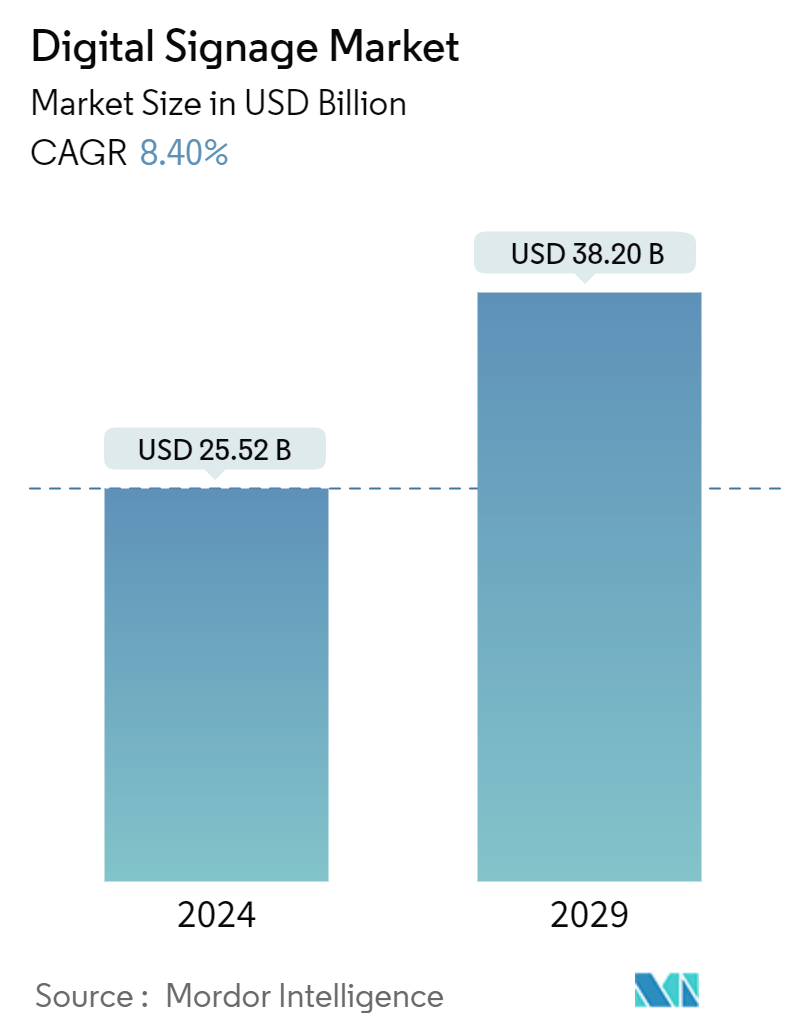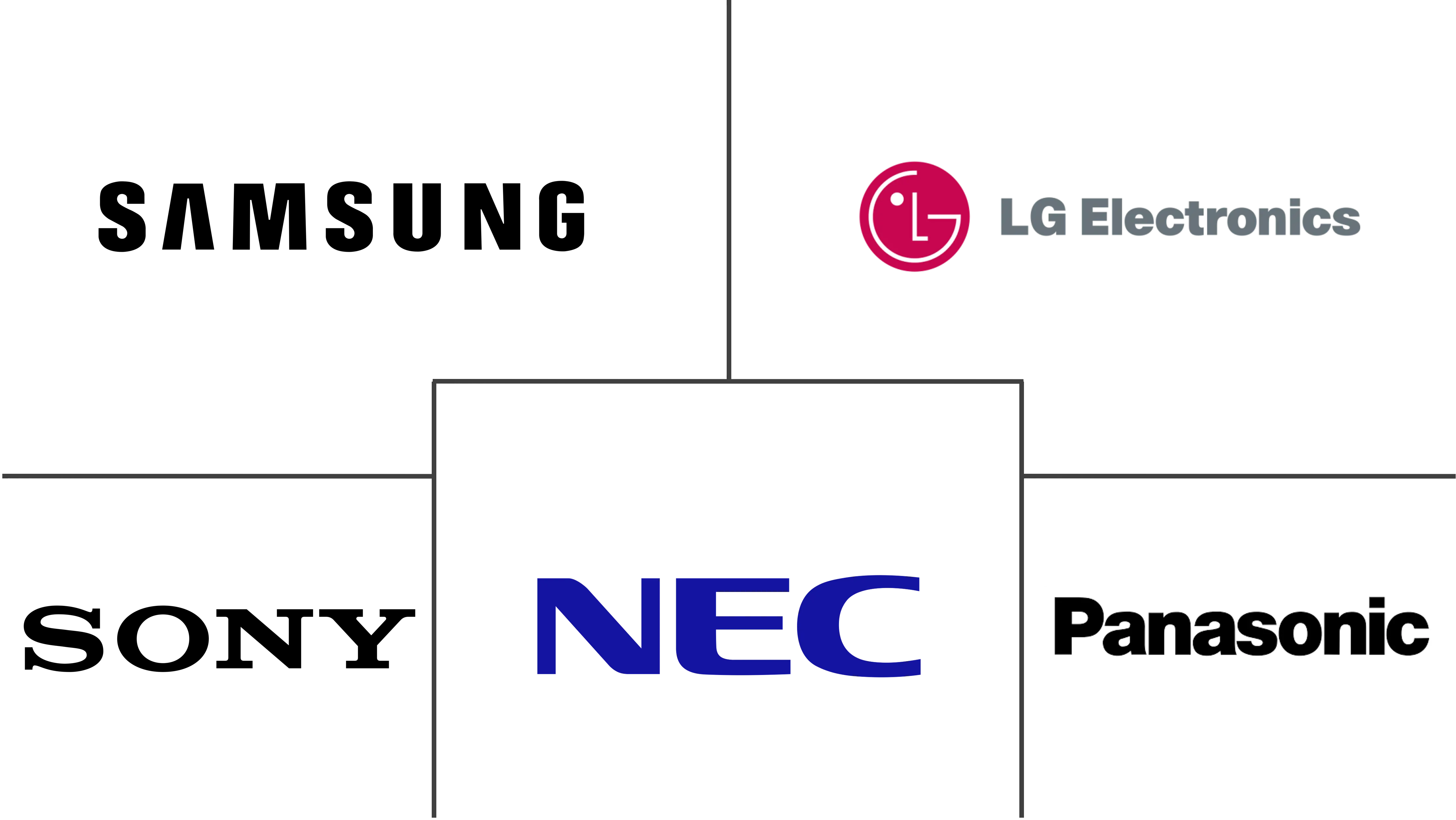Market Size of Digital Signage Industry

| Study Period | 2019 - 2029 |
| Market Size (2024) | USD 25.52 Billion |
| Market Size (2029) | USD 38.20 Billion |
| CAGR (2024 - 2029) | 8.40 % |
| Fastest Growing Market | Asia-Pacific |
| Largest Market | North America |
| Market Concentration | Medium |
Major Players
*Disclaimer: Major Players sorted in no particular order |
Digital Signage Market Analysis
The Digital Signage Market size is estimated at USD 25.52 billion in 2024, and is expected to reach USD 38.20 billion by 2029, growing at a CAGR of 8.40% during the forecast period (2024-2029).
The growth in transport networks, public infrastructure, and new commercial buildings, particularly in developing economies, creates more opportunities in this market. Digital signage is being used in and on all modes of public transportation to attract the attention of on-the-go viewers, providing real-time location and context awareness related to traveler information and advertising. Moreover, it is fast becoming a standard in many educational facilities, with schools and corporate campuses facilitating digital signage systems.
- For instance, in April 2022, Visix Inc. expanded its portfolio of higher education projects by announcing that Wichita State University had chosen an AxisTV Signage Suite digital signage system for its Metroplex convention center. The entire solution included a cloud-hosted CMS, three nano digital signage players, and ten Electronic Paper Room (E-Paper) Signs, which dynamically display events and meetings as they happen.
- Digital signage systems eliminate frequent compatibility and interoperability issues between media players and displays. Furthermore, digital signage boards are being extensively used as arrival and departure boards in airports, known as Flight Information Display Systems (FIDS).
- For instance, in October 2022, Mvix, a significant enterprise digital signage solutions provider, added a new passenger information signage solution for airport displays to its Flight Information Displays (FIDS) Module. The new suite displays flight data for airline counters, gate displays, terminal screens, baggage claim directories, and carousel displays for airports and local hotel properties, powered by real-time flight data services.
- Furthermore, rising customer demand for clear and comprehensive product information drives the adoption of digitized signs. There is also a rise in demand for digitized technology in education. In March 2022, ViewSonic Corp., a global visual solutions provider, showcased its myViewBoard Sens, an educational technology, at the BETT show. This technology is embedded with AI technology that increases student engagement and facilitates wellness in the classroom.
- Along with all these factors, enhancing brand awareness and perception among global leaders is expected to drive the market's growth. However, digital signage boards require high electricity, indirectly affecting maintenance costs. This could hinder the development of the market.
Digital Signage Industry Segmentation
Digital signage happens to be a sub-segment of signage. Technologies like LCD, LED, and projection are used in digital signage to display digital content such as images, video, streaming media, and information. Digital billboards are used in public spaces, transportation systems, museums, stadiums, retail stores, hotels, restaurants, corporate buildings, etc., for wayfinding, exhibitions, marketing, and outdoor advertising.
Digital Signages Market Growth and it is segmented by type (video wall, video screen, kiosk, transparent LCD screen, digital poster), by component (hardware [LCD/LED display, OLED display, media players, projector/projection screens], software, services), by size (below 32, 32 to 52, above 52), by location (in-store, outdoor), by application (retail, transportation, hospitality, corporate, education, government), and by geography (North America, Asia Pacific, Europe, Latin America, Middle East and Africa). The report offers market forecasts and size in value (USD) for all the above segments.
| Type | |
| Video Wall | |
| Video Screen | |
| Kiosk | |
| Transparent LCD Screen | |
| Digital Poster | |
| Other Types |
| Component | |||||||
| |||||||
| Software | |||||||
| Services |
| Size | |
| Below 32' | |
| 32' - 52' | |
| Above 52' |
| Location | |
| In-store | |
| Outdoor |
| Application | |
| Retail | |
| Transportation | |
| Hospitality | |
| Corporate | |
| Education | |
| Government | |
| Other Applications |
| Geography | |
| North America | |
| Asia | |
| Australia and New Zealand | |
| Europe | |
| Latin America | |
| Middle East and Africa |
Digital Signage Market Size Summary
The digital signage market is poised for significant growth, driven by the expansion of transport networks, public infrastructure, and commercial buildings, particularly in developing regions. This technology is increasingly being integrated into various modes of public transportation, educational institutions, and corporate campuses, enhancing real-time communication and advertising capabilities. The market is also witnessing a shift from traditional printed signage to digital solutions, offering cost-effective and secure alternatives. Innovations in display technologies, such as OLED, are further propelling the market by providing superior media presentation and energy efficiency. The adoption of digital signage in sectors like hospitality and education is enhancing brand awareness and improving user engagement, thereby driving market demand.
North America leads the global digital signage market, supported by early technology adoption and the presence of major vendors. The market is characterized by a mix of large corporations and niche players, offering a range of hardware and software solutions. Recent collaborations and product launches, such as Samsung's managed service for small and midsize businesses, highlight the industry's focus on integrated and customizable solutions. The market's growth is also fueled by advancements in cloud-based designs and interactive displays, which are becoming increasingly popular in venues like stadiums and hotels. Despite the high electricity costs associated with digital signage, the benefits of enhanced visibility and interactivity continue to attract investment and interest from various sectors.
Digital Signage Market Size - Table of Contents
-
1. MARKET DYNAMICS
-
1.1 Market Overview
-
1.2 Industry Attractiveness - Porter's Five Forces Analysis
-
1.2.1 Threat of New Entrants
-
1.2.2 Bargaining Power of Buyers
-
1.2.3 Bargaining Power of Suppliers
-
1.2.4 Threat of Substitutes
-
1.2.5 Intensity of Competitive Rivalry
-
-
1.3 Industry Value Chain Analysis
-
1.4 Assessment of Impact of COVID-19 on the Industry
-
1.5 Market Drivers
-
1.5.1 Convergence of Digital Signage with Cross-platform Media Tool
-
1.5.2 Evolution of Turnkey Solutions
-
1.5.3 Diminishing Cost of Infrastructure Leading to Higher Penetration
-
-
1.6 Market Restraints
-
1.6.1 Poor Integration with Complex Business Requirements
-
-
-
2. MARKET SEGMENTATION
-
2.1 Type
-
2.1.1 Video Wall
-
2.1.2 Video Screen
-
2.1.3 Kiosk
-
2.1.4 Transparent LCD Screen
-
2.1.5 Digital Poster
-
2.1.6 Other Types
-
-
2.2 Component
-
2.2.1 Hardware
-
2.2.1.1 LCD/LED Display
-
2.2.1.2 OLED Display
-
2.2.1.3 Media Players
-
2.2.1.4 Projector/Projection Screens
-
2.2.1.5 Other Hardware
-
-
2.2.2 Software
-
2.2.3 Services
-
-
2.3 Size
-
2.3.1 Below 32'
-
2.3.2 32' - 52'
-
2.3.3 Above 52'
-
-
2.4 Location
-
2.4.1 In-store
-
2.4.2 Outdoor
-
-
2.5 Application
-
2.5.1 Retail
-
2.5.2 Transportation
-
2.5.3 Hospitality
-
2.5.4 Corporate
-
2.5.5 Education
-
2.5.6 Government
-
2.5.7 Other Applications
-
-
2.6 Geography
-
2.6.1 North America
-
2.6.2 Asia
-
2.6.3 Australia and New Zealand
-
2.6.4 Europe
-
2.6.5 Latin America
-
2.6.6 Middle East and Africa
-
-
Digital Signage Market Size FAQs
How big is the Digital Signage Market?
The Digital Signage Market size is expected to reach USD 25.52 billion in 2024 and grow at a CAGR of 8.40% to reach USD 38.20 billion by 2029.
What is the current Digital Signage Market size?
In 2024, the Digital Signage Market size is expected to reach USD 25.52 billion.

